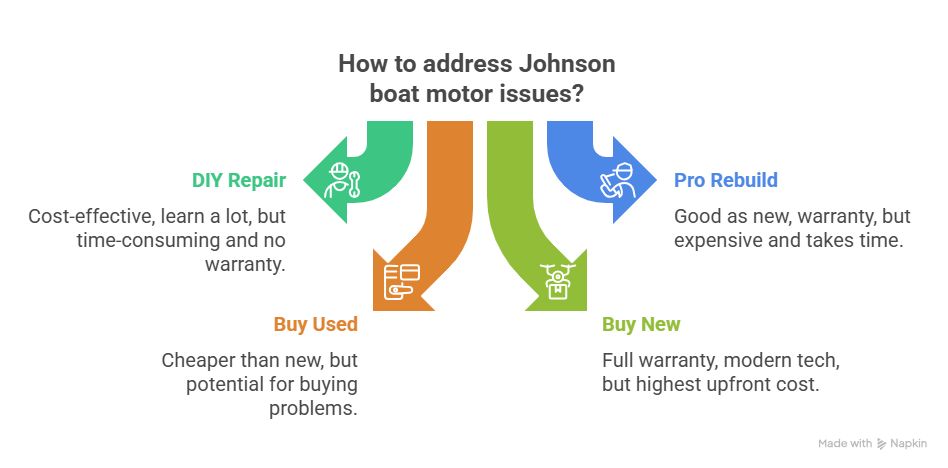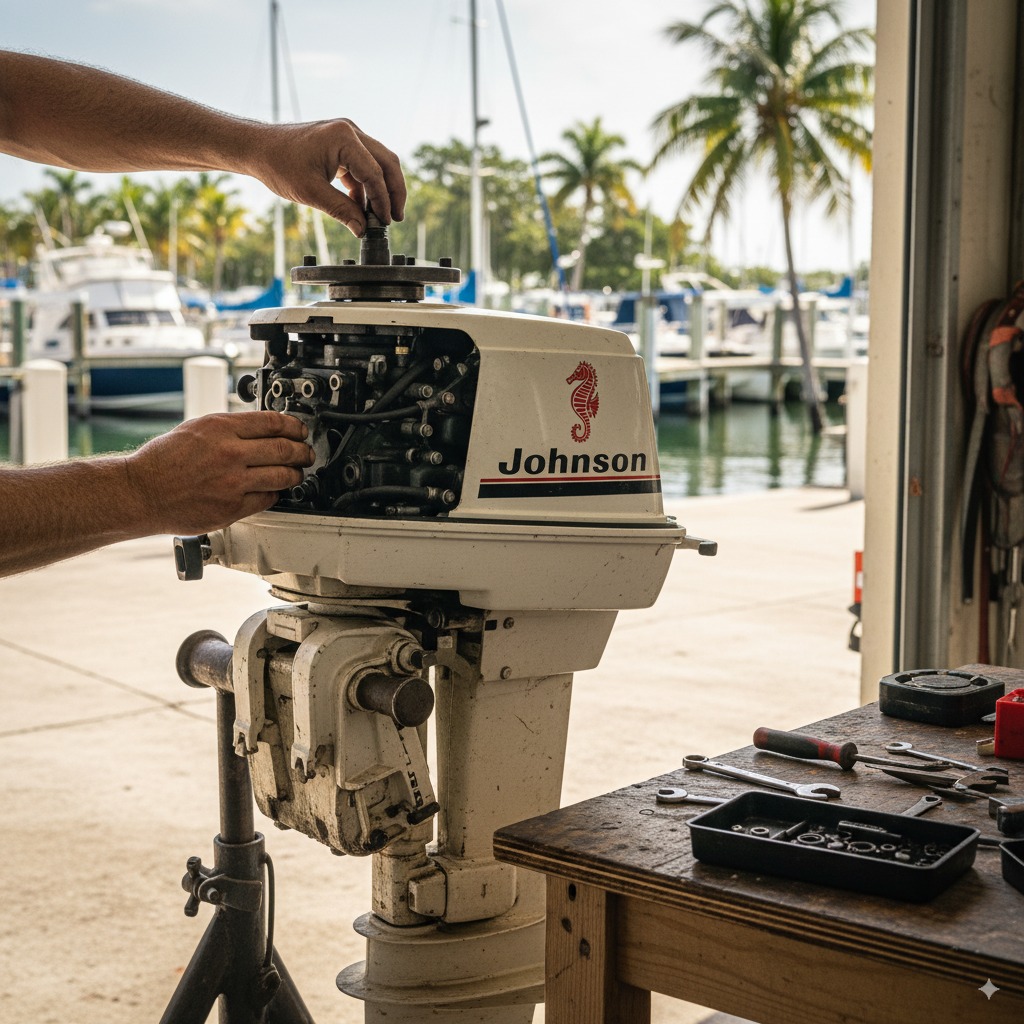That Familiar Sputter…
I’ve got a real soft spot for those old white Johnson outboards. They’re like the classic cars of the water—simple, tough, and they just keep going. But even the toughest workhorse has its bad days. I can’t count the number of calls I’ve gotten from guys at Dinner Key Marina or out by Stiltsville with the same story: “Alex, my Johnson just won’t start,” or “It’s sputtering and dying on me.”
It’s that moment that ruins a perfect day on the water. But here’s the thing I tell everyone: nine times out of ten, a little knowledge and the right approach can get that motor purring again. This isn’t black magic; it’s just good, old-fashioned mechanics. A proper johnson boat motor repair is something you can absolutely get a handle on.
So, forget the frustration. I’m going to walk you through how I approach these iconic motors, from figuring out what’s wrong to deciding if it’s worth fixing. This is my playbook, learned over 15 years of busting my knuckles on these engines right here in Miami.
Table of Contents
First Thing’s First: Know Your Motor
Before you even think about picking up a wrench, you need to know exactly what you’re working on. The first step in any johnson boat motor repair is to find that little metal plate with the model and serial number. Sometimes it’s worn down or painted over, which is a real pain, but it’s your key to everything.
Once you have that number, your next move is to get the right service manual.
- Factory Manuals (OMC/BRP): These are the holy grail. They have the exact specs, diagrams, and step-by-step procedures for your motor.
- Aftermarket Manuals (Seloc, Clymer): These are great too, often easier for beginners to read. They cover a range of years, so just make sure yours is included.
Trying to do a johnson boat motor repair without the right manual is like trying to navigate the Keys without a chart. You’re just asking for trouble.
The Usual Suspects: Common Johnson Problems I See All the Time
After years of working on these, you start to see the same problems pop up again and again. Here are the big ones:
- It Won’t Start or Idles Rough: This is the number one call I get. It usually points to a problem in one of two places: fuel or spark. A dirty carburetor, a clogged fuel filter, or old spark plugs are the most common culprits.
- Loses Power at High Speed: If your motor feels like it’s “missing” or bogging down when you open it up, I immediately look at the ignition. On the older models, the contact points get worn or pitted, which messes with your spark. A proper johnson boat motor repair often involves replacing these.
- Overheating: This is a silent killer. If you see steam or the warning alarm goes off, shut it down immediately. 99% of the time, this is a failed water pump impeller. It’s a cheap rubber part, but neglecting it can cook your engine and lead to a catastrophic failure.
- Electrical Gremlins: Tilt/trim not working? Starter just clicks? These issues usually trace back to a bad relay, a corroded ground wire, or a faulty switch. A multimeter is your best friend here.
My Troubleshooting Playbook: How to Find the Problem
Alright, so your motor is acting up. Don’t just start replacing parts randomly. That’s how you waste a Saturday and a lot of money. Follow a system.
- Safety First: Disconnect the battery. Make sure you’re in a well-ventilated area. I’ve seen guys get a nasty shock or start a fuel fire by being careless.
- Check Compression: This is the engine’s health check. A simple compression tester will tell you if you have a serious internal problem. Most healthy Johnsons should be around 90-100 PSI per cylinder, but check your manual. If the numbers are low or uneven, you’re looking at a more serious johnson boat motor repair.
- Check for Spark: Pull the plugs and test for a strong, blue spark. A weak, orange spark won’t cut it. This will lead you to check coils, points, and wires.
- Check the Fuel System: Is fuel actually getting to the carburetor? I start at the tank and work my way forward. Check the bulb, the filter, and then the carb itself. Often, a good carburetor cleaning is all the johnson boat motor repair it needs.

How to Keep Your Johnson Out of My Shop: Proactive Maintenance
The best johnson boat motor repair is the one you never have to do. A little bit of preventative maintenance goes a long, long way.
- Change the Gear Oil: Do this every season. If it comes out looking milky like a milkshake, you’ve got water in there from a bad seal. That needs to be fixed ASAP.
- Replace the Impeller: Don’t guess. Change it every 1-2 years, period. It’s the cheapest insurance you can buy for your motor. I keep a box of common ones in my truck.
- Spark Plugs and Fuel Filters: These are cheap and easy to replace. Do it at the start of every season.
- Stabilize Your Fuel: Especially with ethanol fuel, use a good stabilizer. It prevents the fuel from going bad and gumming up your carburetor.
Repair or Replace? The Big Decision
At some point, you might face the tough question: is it worth fixing? I get asked this a lot. Here’s a little table I put together based on jobs I’ve done here in Miami to help you decide.
| Option | Estimated Cost (Mid-Size Johnson) | Pros | Cons | My Take |
|---|---|---|---|---|
| DIY Repair | $50 – $500 | Super cheap, learn a lot. | Time-consuming, no warranty. | Great for fuel/spark issues. Not for major internal work. |
| Pro Rebuild | $2,000 – $6,000 | Good as new, often w/ warranty. | Expensive, takes time. | Smart choice if the rest of the boat is in great shape. |
| Buy Used | $1,500 – $5,000 | Cheaper than new. | You could be buying someone else’s problems. | Risky. Do a full inspection and compression test before buying. |
| Buy New | $8,000+ | Full warranty, modern tech. | Highest upfront cost. | The ultimate solution if your budget allows and you want zero hassle. |
Honestly, a professional rebuild of a classic Johnson often makes sense. You get a reliable motor for a fraction of the cost of a new one. This is a common path for a johnson boat motor repair when the engine has good “bones.”
FAQ: Quick Questions I Get at the Dock
How hard is it to change a water pump impeller myself?
Honestly, it’s not that bad if you’re patient and have the manual. It involves dropping the lower unit. The first time might take you a couple of hours. I’d rate it a 6/10 on the difficulty scale for a DIYer.
Is ethanol fuel really that bad for my old Johnson?
Yes, it is. It can eat old fuel lines and gum up carburetors. If you have to use it, use a good enzyme or stabilizer treatment with every fill-up. It makes a huge difference in the number of fuel-related johnson boat motor repair jobs I see.
Where do you find parts for these old motors?
It’s a bit of a treasure hunt! I use sites like MarineEngine.com, Crowley Marine, and even eBay. There are also specialized salvage yards. The key is having that exact model number.
My motor shakes a lot at idle. What is it?
It’s likely a carburetor issue. The low-speed jet is probably clogged, or the idle mixture needs adjustment. A good carb cleaning and adjustment usually smooths it right out.
I have a spark, but it won’t start. Now what?
A weak spark is as bad as no spark. It needs to be a strong, blue spark that can jump a 7/16″ gap. If it’s orange and weak, your ignition system still needs work. Don’t rule out a johnson boat motor repair on the ignition side just because you see a little flicker.
Final Words: Keep Those Classics Running
That old Johnson on your transom is a piece of boating history. With a little care and the right knowledge, there’s no reason it can’t give you years more of reliable service. Don’t be intimidated by a sputter or a stall.
Start with the basics: get the right manual, do your preventative maintenance, and learn how to diagnose the simple stuff. You’ll be amazed at what you can fix yourself. And for the big jobs, now you know when it’s time to call in a pro. A good johnson boat motor repair is all about making smart choices.
Now, go get that engine purring. The water’s waiting.
Author Bio
I’m Alex, a 15-year marine technician in South Florida, ABYC-certified. I’ve probably brought hundreds of classic Johnson and Evinrude outboards back to life. From simple carb cleanings on a 9.9hp to full powerhead rebuilds on a V6, I’ve seen and fixed it all at marinas like Bahia Mar and Coconut Grove.


Leave a Reply